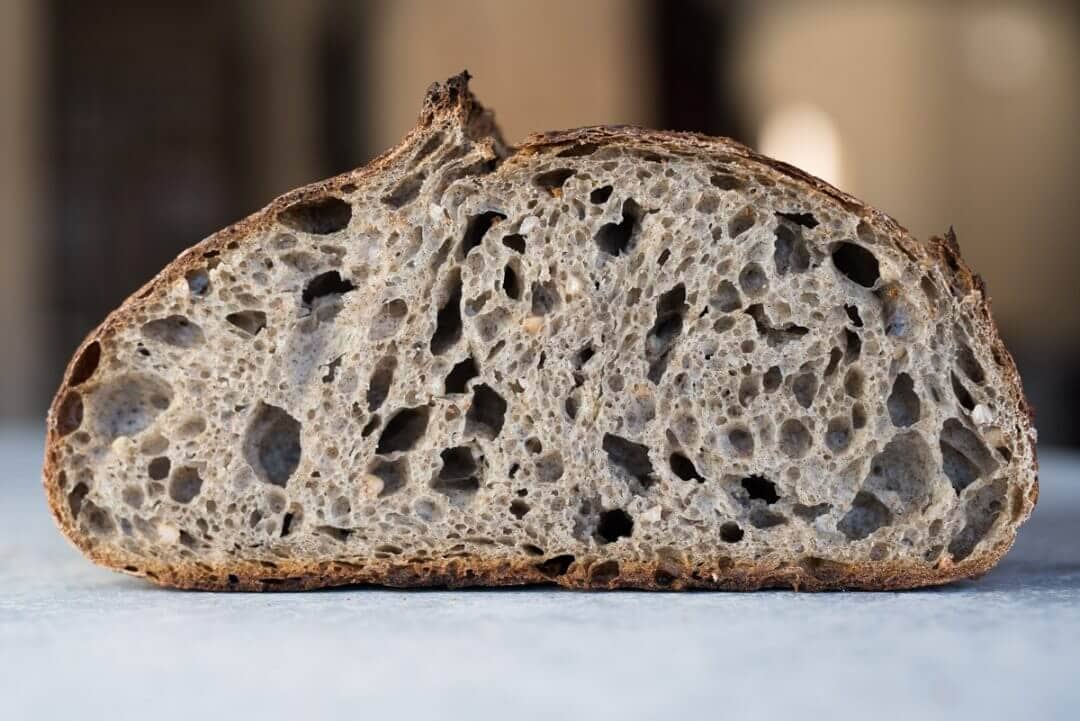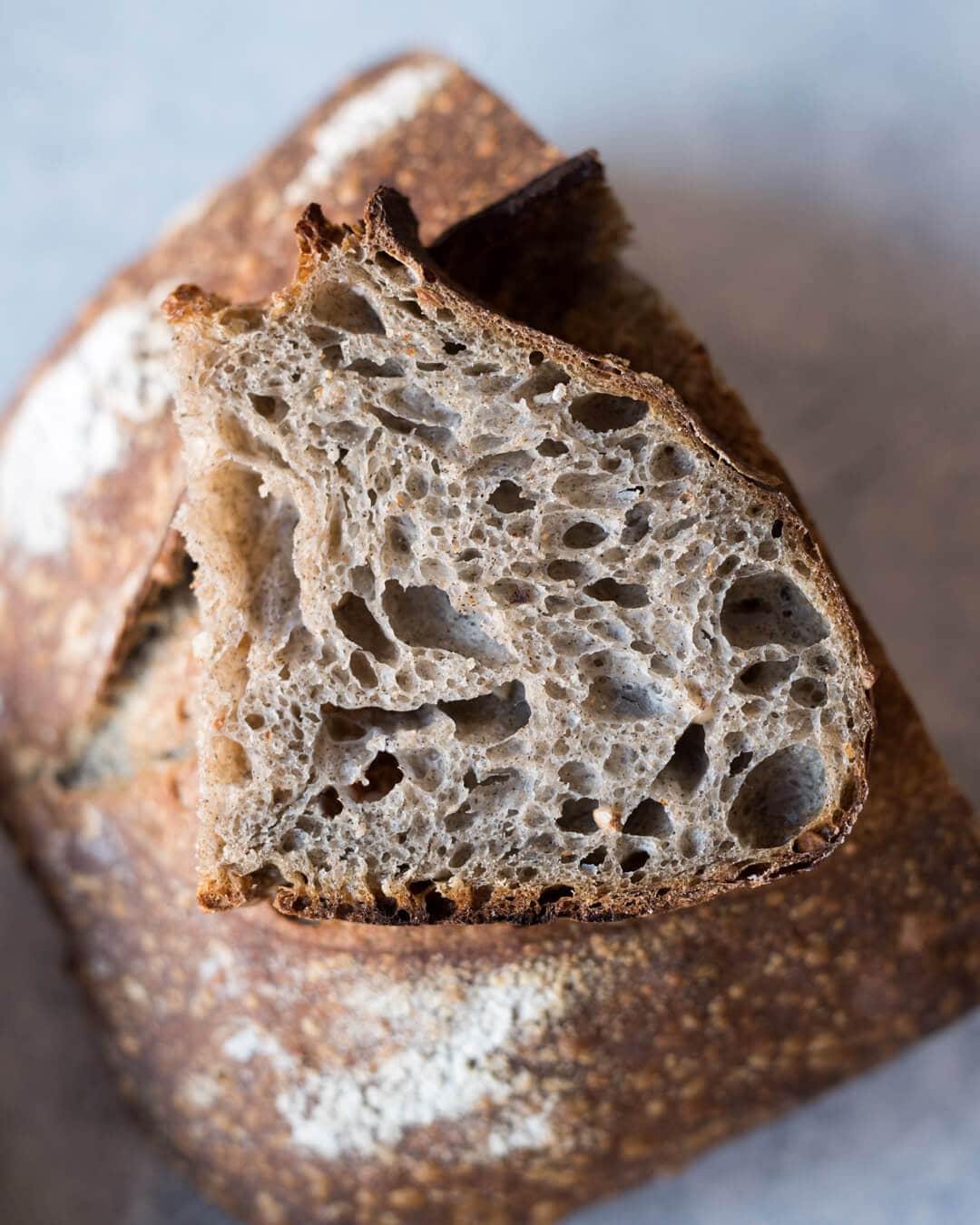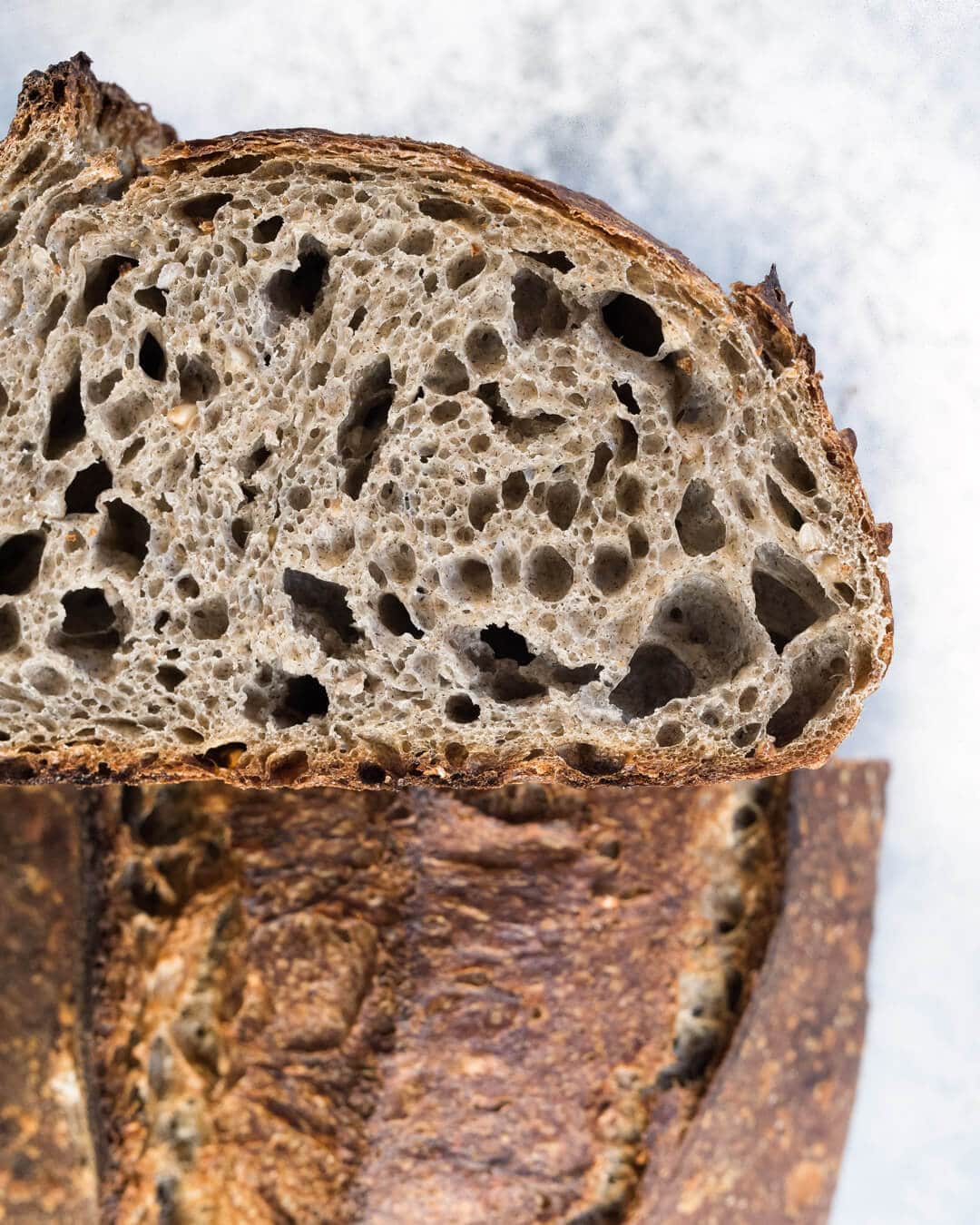After a few minutes shy of finishing my typical hand mix, I looked down at the dark dough oozing between my fingers and thought to myself: “Wow, this looks and smells remarkably wonderful.”
When working again and again with bread dough, you come to expect a certain color palette: deep reds, nut-browns, soft tans, milky whites, and every possible shade therein—for the most part, this palette neatly defines your bread baking world. Even when changing to freshly milled flour or a new type of grain you can usually be assured the color will be along that spectrum. Not so with whole grain buckwheat. Just a small percentage of the milled, dark and menacing grain-like seed transformed the entire dough to something more like itself: a stunning dark gray, almost black, hue. The earthy aroma surfaced memories of fresh cut soba noodles I had in a modest but astounding restaurant in Japan.
I can vividly recount this exposure to buckwheat: it was during my recent trip to Japan when we serendipitously visited in at the smallest restaurant I’ve ever encountered. In fact, the only indication it was a restaurant was the unpretentious and familiar symbol on the door indicating it as such. No open windows, no lit up flashy signs, no line snaking around the corner. Just a haven inside that sheltered diners from the hustle and liveliness a short distance from their tables. Almost every seat in the restaurant was occupied, and a survey of the diners immediately told me the dish to order was a large bowl of steaming soup.

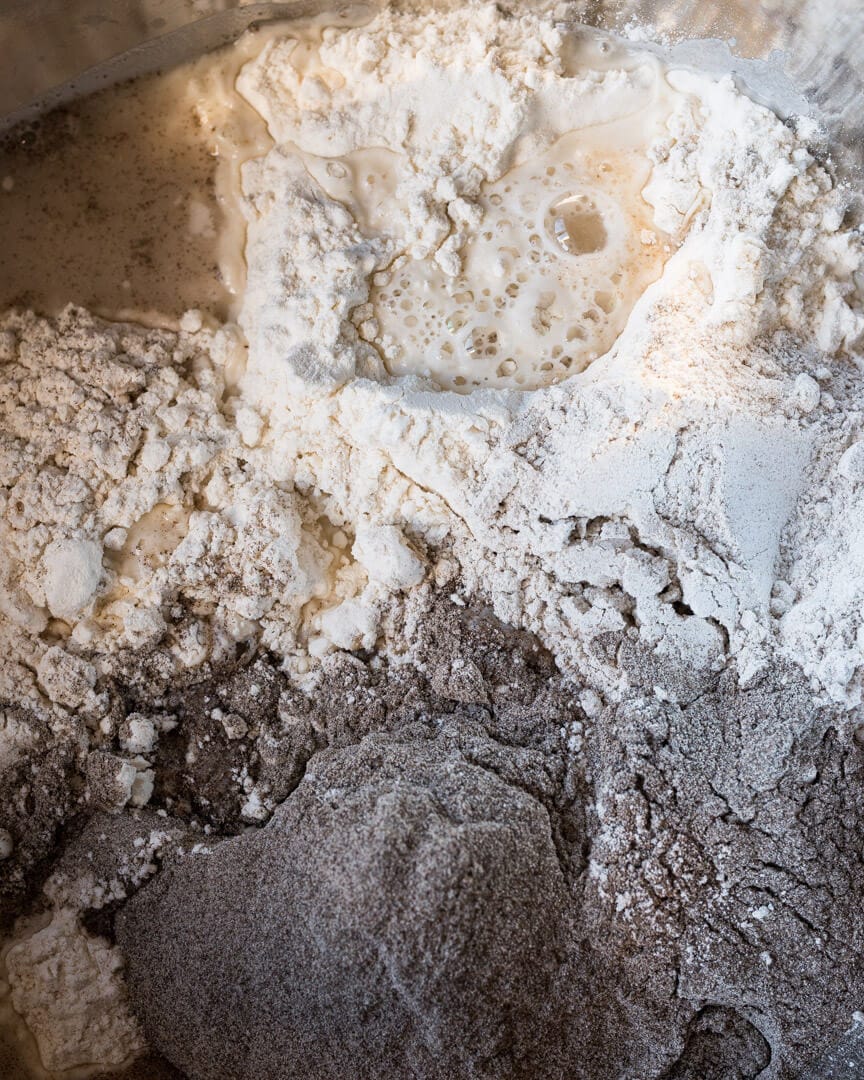
The small shop was run by an elderly gentleman and his wife who welcomed us inside with a bow and an open hand. After ordering kitsune soba, per their recommendation and the unintentional recommendation of all other patrons, I proceeded to have one of the best meals of my entire trip. The vaguely strong flavor of buckwheat noodles in their delectable broth was nothing like any food I had had before and, to the astonishment of the owner, I ordered a second bowl to split with a friend. That one restaurant visit opened my eyes to this wonderful pseudocereal and piqued my desire to work with buckwheat flour in my own kitchen—and of course in baking bread.
With the arrival of very cold weather here in New Mexico and soups on the regular in my kitchen, I found myself thinking back to that meal and the stage was set for me to begin experimenting with the earthy, dark buckwheat flour.
Sometimes when trying to create a sourdough formula, I find myself in the mood for bread that’s uncomplicated, light as air, crisp, and very crunchy. Other times I want something more elaborate, something deep flavored with many layers of complexity, a touch more sourness, and very flavor-forward. Buckwheat fits perfectly into the latter category, and channeling inspiration from my recent experience in Japan, I knew it would be a perfect fit for this season.
Flour & Seed Selection

Originally, I intended on using freshly milled buckwheat in this formula but was unable to find the whole grain variety at my local market—I only found buckwheat groats (hulled buckwheat). Unfortunately, it’s the outer, hard hull in buckwheat that gives the flour its dark appearance. And while I’m not one to usually choose appearances over taste, I found the whole buckwheat to also have an incredible aroma and flavor. I was committed.
When experimenting with the total percentage of buckwheat flour used in this formula, I ran the gamut from one percent all the way up to ten percent. However, because buckwheat has no gluten, at 10% the interior of the loaf was rather dense—it was shocking how big of an impact this small percentage imparted on the structure of the loaf. Additionally, at this percentage, I felt the intense buckwheat flavor was a bit too forward, overshadowing just about everything else. I finally dialed things back to 5% and found the sweet spot: just enough of that earthy flavor without overpowering the rest of the wheat and fermentation flavors.
In addition to buckwheat, and channeling a little of my previous Multigrain Spelt Sourdough formula, I decided to work in a small amount of rye flour. The flavor of light rye compliments the earthy buckwheat without adding any additional bitterness. It also helps slightly increase acetic acid production, adding a little more sourness to the result. I find that the slightly more sour flavor works very well with the overall flavor profile and my desire for a more complex bread.
Sprouting Buckwheat Groats
Since I’m already using buckwheat flour why include sprouted buckwheat groats? I treated the sprouts as more of an “add in” to contribute even more flavor to this bread, much like adding in seeds or nuts. As I mentioned, because I had intended on milling fresh buckwheat for this recipe, I had a sack of (raw) buckwheat groats lying around. I decided to try and sprout them to see just how hard it might be.
Sprouts represent the point of greatest vitality in the life cycle of a plant.
Paul Pitchford, Healing with Whole Foods
Turns out it’s incredibly simple, and my test bakes with added buckwheat sprouts had a subtle sweetness that I just couldn’t part with; I felt their addition only added to the overall appeal to this loaf.
In addition to the added flavor and texture, the act of sprouting seeds begins the transformation from seed to plant. This transformation makes their nutrients more bioavailable to us during digestion, as a sort of “predigestion” where the nutrients in the seed become easier to absorb and utilize by our bodies.
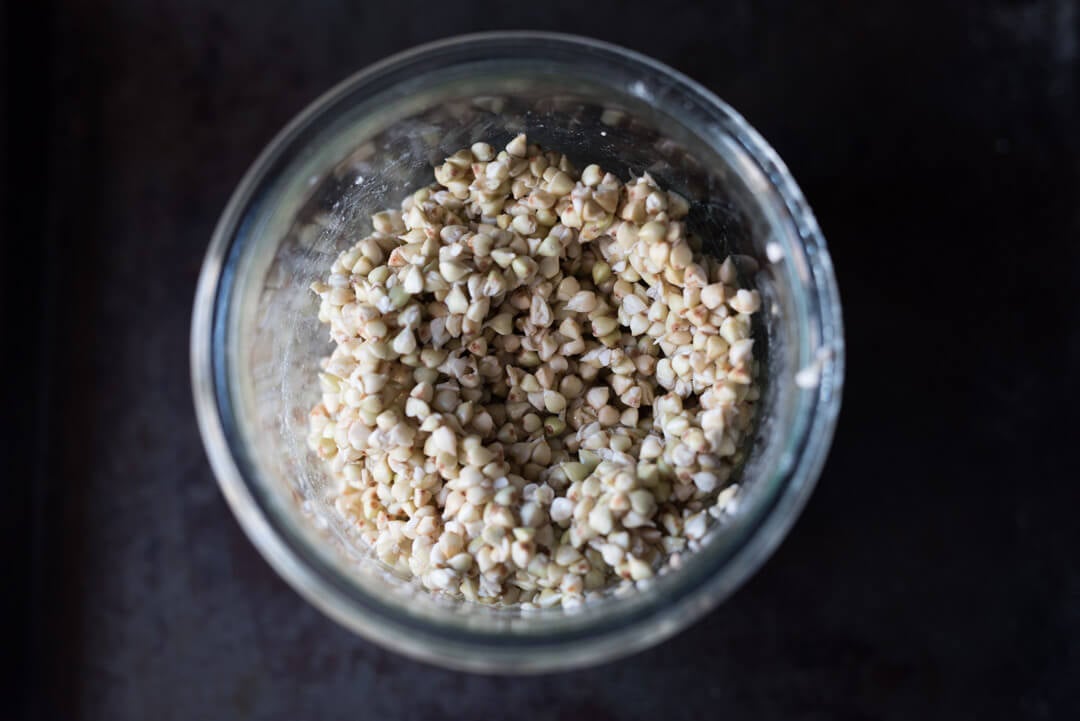
Sprouting the groats is a very straightforward process with a few caveats.
First, ensure the groats are not toasted (these will not sprout). Raw groats will have a light color that is almost green, opposed to toasted groats which are darker brown and, well, look toasted.
Second, the warmer the ambient temperature at which the groats are stored the better; sprouting seems to move at a faster pace when groats are kept at around 75°F – 80°F (23-26°C). I got into a routine of preparing groats the evening before a bake, keeping them at a warm temperature so that they would be ready the next day in the afternoon when bulk fermentation rolled around. I would suggest trying to sprout a small amount, say 50 grams, a few days before you plan to bake this recipe to judge just how long it takes for the groats to sprout for you and your environment.

Finally, you can use the refrigerator to stall the sprouting process: if the sprouts are extending shoots too fast, place the jar in the fridge and then pull it out right when bulk fermentation begins. This way the sprouts come up to room temperature by the time they are needed (after the second set of stretch and folds, about 1 hour into bulk).
Sprouting process:
- Rinse the raw buckwheat groats several times under water (I used a mesh sieve to hold them).
- Place the groats in a jar and cover with water for 1-2 hours.
- Drain the jar and rinse the groats with water (again, using a mesh sieve). Place the groats back in the dry jar and cover with a kitchen towel or very loose fitting lid.
- After several hours (I waited 8 hours or so, until the morning) drain the jar, rinse the groats under water again, place back into the jar and fluff them up with a spoon to aerate (good airflow is essential for sprouting).
- Wait several hours and check to see if sprouts are emerging, if not continue to drain/rise/aerate until sprouting occurs.
My very first time I tried to sprout these groats I saw activity after one day—it’s not a difficult thing, and the fridge is always a great option to help synchronize the timing between dough development and sprouting.
Sprouted Buckwheat Sourdough
Vitals
| Total Dough Weight | 1900 grams |
| Pre-fermented Flour | 6.50% |
| Hydration | 85% |
| Yield | 2 x 950 gram loaves |
Levain Build
| Weight | Ingredient | Baker’s Percentage |
|---|---|---|
| 6g | Mature liquid starter (100% hydration) | 10% |
| 63g | Type 85 Flour (Central Milling T-85 Malted) | 100% |
| 63g | Water | 100% |

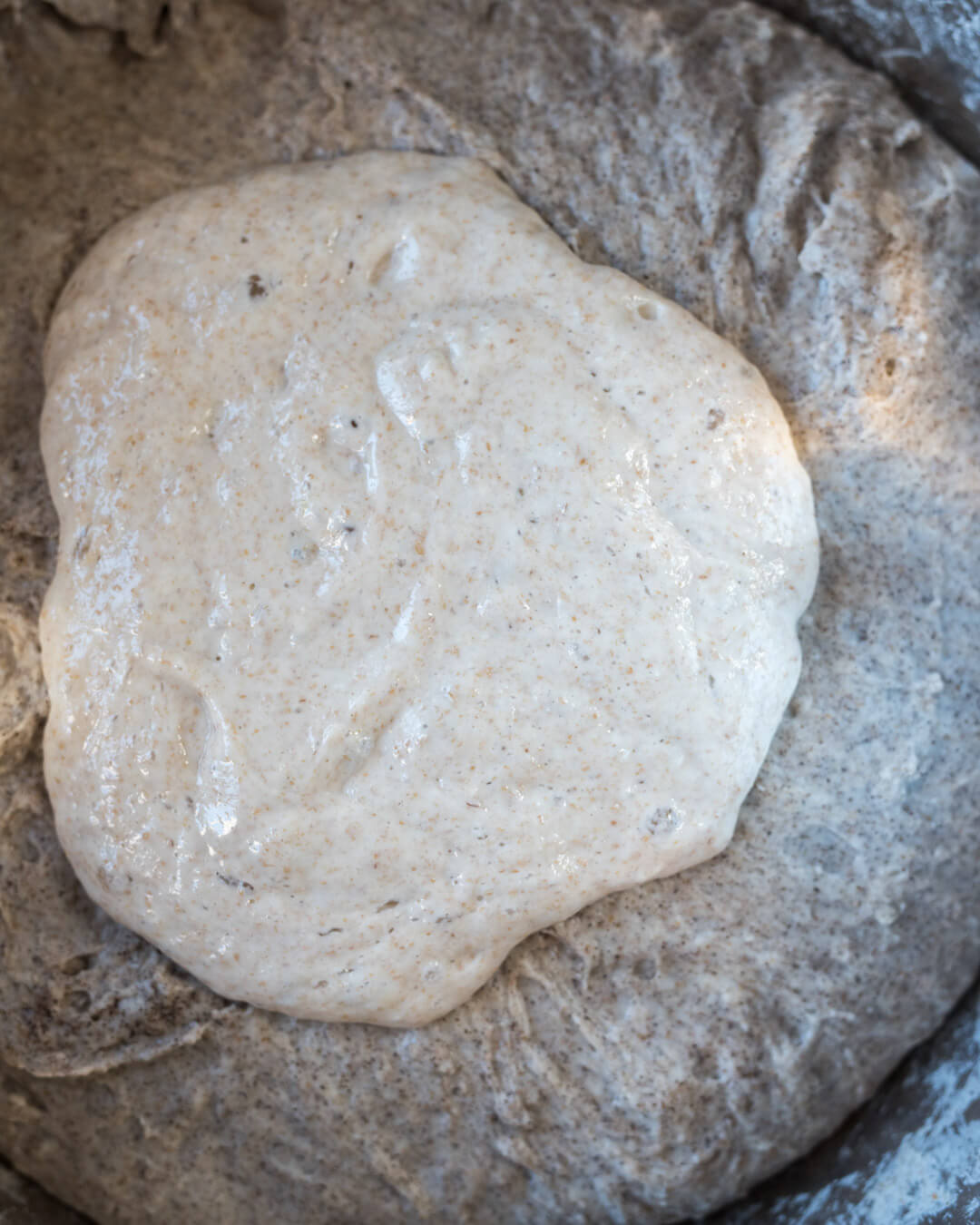
Dough Formula
Target final dough temperature (FDT) is 77°F (25°C).
Note that the baker’s percentages listed below are with respect to the final dough ingredients and do not take into account the levain.
| Weight | Ingredient | Baker’s Percentage |
|---|---|---|
| 481g | Malted Bread Flour (Giusto’s Artisan Baker Flour Malted) | 53.48% |
| 178g | Type 85 Flour(Central Milling Type 85 Malted) | 19.79% |
| 144g | High Gluten Bread Flour, ~13.5% Protein (Central Milling High Mountain) | 16.04% |
| 48g | Whole Grain Buckwheat Flour (Bob’s Red Mill Whole Grain Buckwheat) | 5.35% |
| 48g | Medium Rye Flour (Central Milling Medium Rye Flour) | 5.35% |
| 96g | Sprouted Buckwheat Groats | 10.70% |
| 755g | Water | 83.96% |
| 18g | Salt | 2.03% |
| 131g | Mature, 100% hydration liquid levain | 14.60% |
Method
1. Sprout Buckwheat Groats – the night before mixing the dough
Following the abovementioned process, rinse the buckwheat groats several times and soak them in water for one hour. After this rinse them and place them into a dry jar overnight.
1. Levain & Fluff Groats – 6:30 a.m.
Build the liquid levain (everything listed in the Levain Build section above) in the morning and store somewhere around 77-80°F (25-26°C) ambient.
Check on the buckwheat groats: rinse them under water and place them back into their jar, fluff a little with a spoon to ensure they are aerated.
2. Autolyse – 3:30 p.m.
Mix flour and water (reserve 100g water for the mix, later) in a bowl until all dry bits are hydrated. Cover bowl and store somewhere warm (around 75-78°F/23-26°C) for 2 hours.
3. Mix – 5:30 p.m.
Add the called for levain and about half of the reserved water to the mixing bowl, mix until well combined.
Dump the dough onto the counter and slap and fold the dough (French fold) for about 5 minutes, just until the dough starts to show signs of a smooth surface. If you aren’t comfortable with slap/fold method or don’t like it, you can do stretch and folds in the bowl until the dough tightens up and becomes harder to stretch out and fold over.
Let the dough rest 15 minutes.
When finished with the slap and fold, sprinkle the salt on top of the dough and use the remaining water to help it dissolve. Pinch through a few times and fold the dough over itself to help incorporate. Perform an additional 3 minutes of slap and fold to build even more strength in the dough. It should come together and be slightly smooth but still a tad sticky.
Transfer the dough to a tub or thick-walled bowl for bulk fermentation.
4. Bulk Fermentation – 6:00 p.m. to 9:30 p.m.
At an ambient temperature of 77-80°F (25-26°C), bulk fermentation should go for about 3 hours and 30 minutes.
Add the sprouted buckwheat groats to the dough before the second set of stretch and folds. Spread a thin layer (about 1/4 of the total sprouts) on top of the rested dough with wet hands and do one fold. Then, spread another 1/4 of the spouts and fold again. Repeat for four folds using all the sprouts.
Perform a total of 3 sets of stretch and folds during the bulk fermentation, spaced out by 30 minutes. If after the last set of stretch and folds the dough feels overly slack, give it another set of stretch and folds for a total of four. After the final set, let the dough rest for the remainder of bulk.
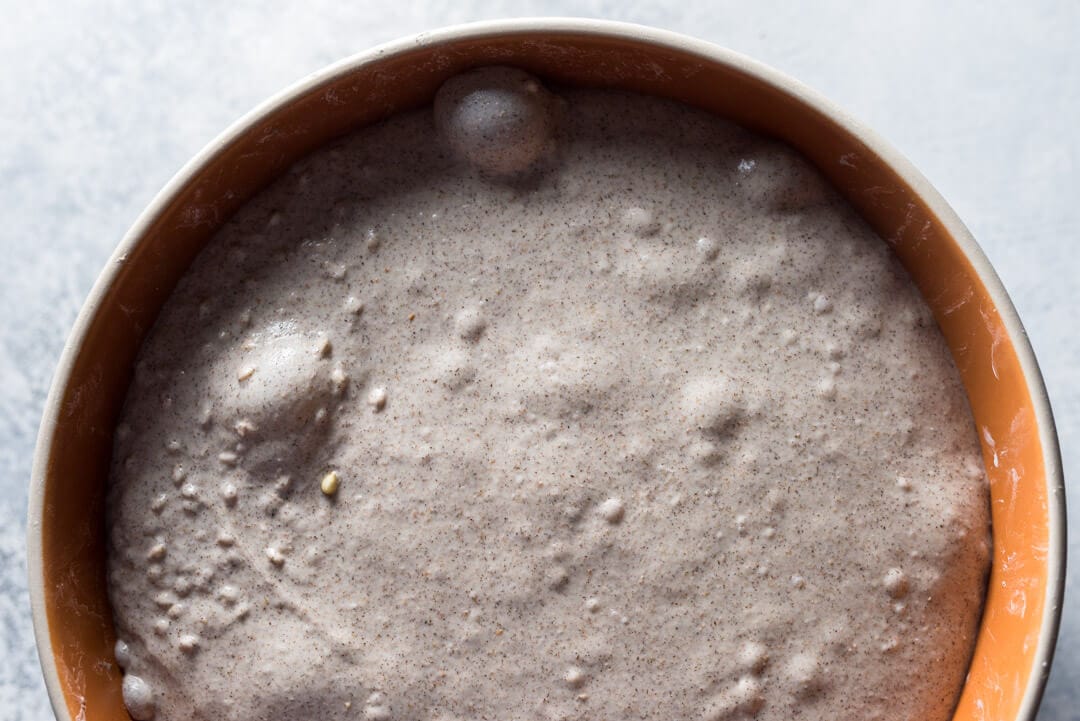
I decided to end the bulk fermentation when I saw the dough look like in the picture below. You can see that it’s risen significantly, there are plenty of bubbles on top and just below the surface, and most importantly, the edge where the dough meets the bowl is domed, convex. This is a good sign your dough is strong enough and ready to be divided.
5. Divide & Preshape – 9:30 p.m.
Dump the dough from the bulk container to an un-floured work surface. The dough will be sticky and a little slack, so use a bench knife and floured hand to gently preshape the dough into two round boules. Let rest 25 minutes uncovered.
6. Shape – 9:55 p.m.
Flour the work surface and the top of each rested dough. Working with one at a time, flip the resting round over onto the floured surface and fold the top half up and over to the middle and the bottom half up and over the recently folded top. You’ll have a long horizontal rectangle sitting in front of you. Turn the rectangle 90° and grab a small portion of the top, pull up and fold over a little bit, pressing down to seal. Take the rolled top and continue to gently roll it down toward your body with two hands working together. As you do each roll and work your way down the vertical rectangle, use your thumbs to gently press the dough into itself.
For more instruction on how to shape this dough as an oblong loaf, see my post on how to shape a batard.
Once shaped, transfer each to a basket lightly dusted with white rice flour, seam side up.
7. Rest & Proof – 10:00 p.m.
Cover each basket with plastic and then place it in the refrigerator at 38ºF for 9-10 hours.
8. Bake – Next Morning: Preheat oven at 6:30 a.m., Bake at 77:30 a.m.
Preheat oven for one hour at 450°F (232°C).
Take out both of the baskets from the fridge and cut a piece of parchment paper to fit over the top, quickly invert each basket onto each piece of parchment. Using a sharp razor blade fastened to a stick (or a lame) score the top of each at a shallow angle to the dough and just deep enough to cut below the top skin of the dough. Start at the top of the oblong loaf and with a single decisive stroke cut from top to bottom with a slight outward bend.
Bake the loaves at 450°F (232°C) for 20 minutes with steam, then remove the steaming pans from inside the oven. Bake the loaves for an additional 30 minutes or until done.
I steamed my oven in my usual way, described here in my post on how to steam your home oven for baking.
Conclusion

At first sight, this enigmatic sprouted buckwheat sourdough spurs the question every time: “What kind of bread is this?” The deep dark fissures and a slight gray cast are a prelude to what this bread is all about. A touch of sweetness, slightly sour, earthy, and creamy—a concert of flavors and textures in this sprouted buckwheat sourdough. This bread is a perfect companion for the cold days ahead.
Crust
Wonderful colors, ample crunch, and yet very thin. The crust seems to have a little added color by the increased sugars from the sprouted groats—very evident at each bite. When toasted even further, the crust transforms into a delicious and brittle cracker.
Crumb
The dark gray interior hue on the crumb is a stunner. It’s something not usually seen in bread, and it only adds to the charm of this loaf—it breaks from the traditional baking color palette in an unexpected and delightful way. The interior texture is not gummy but rather soft and interjects with a crunchy chew at each sprouted buckwheat discovery.
Taste
This loaf met the expectation I had for it at the onset: I wanted a complex, multifaceted bread with a subtle sweetness from the sprouted groats, earthy flavors from the whole buckwheat flour, increased sourness from the longer proof time and rye flour, and an overall balanced flavor profile when paired together.
While I still find myself dreaming of that steaming hot bowl of fresh soba I had in Japan several months ago, at least this bread, with its earthy whole grain buckwheat flavor and subtle sweet contribution from the sprouts, brings me back even if just for a moment.
I know one thing for certain: this sprouted buckwheat sourdough will be a regular staple here in my kitchen throughout this cold winter.
Buon appetito!
If you use this recipe, tag @maurizio on Instagram so I can take a look!


